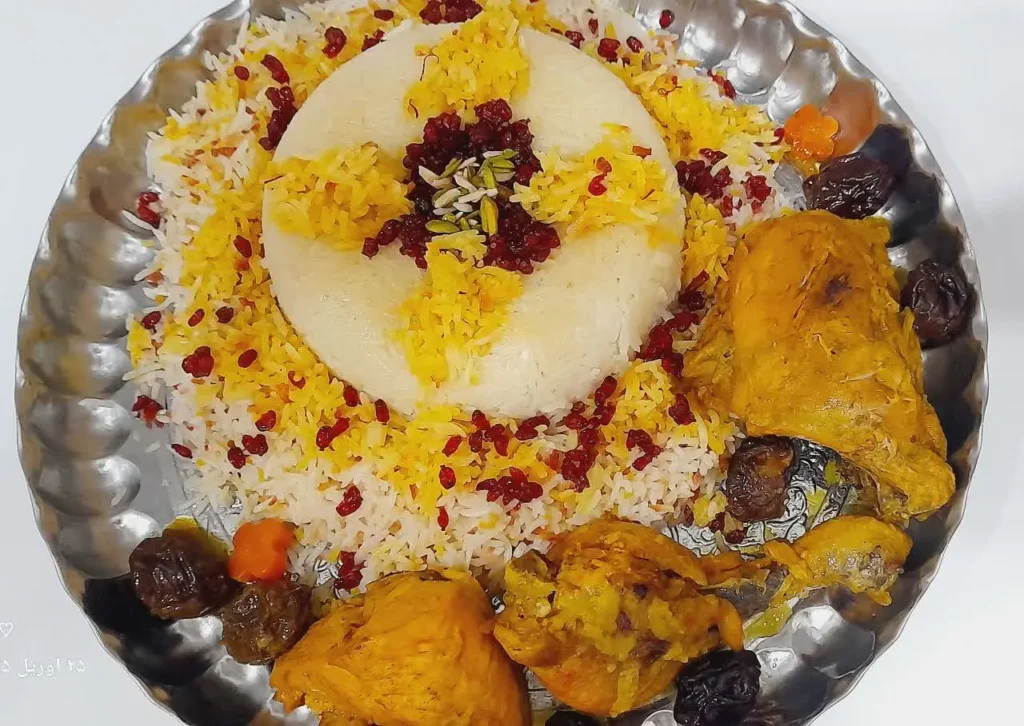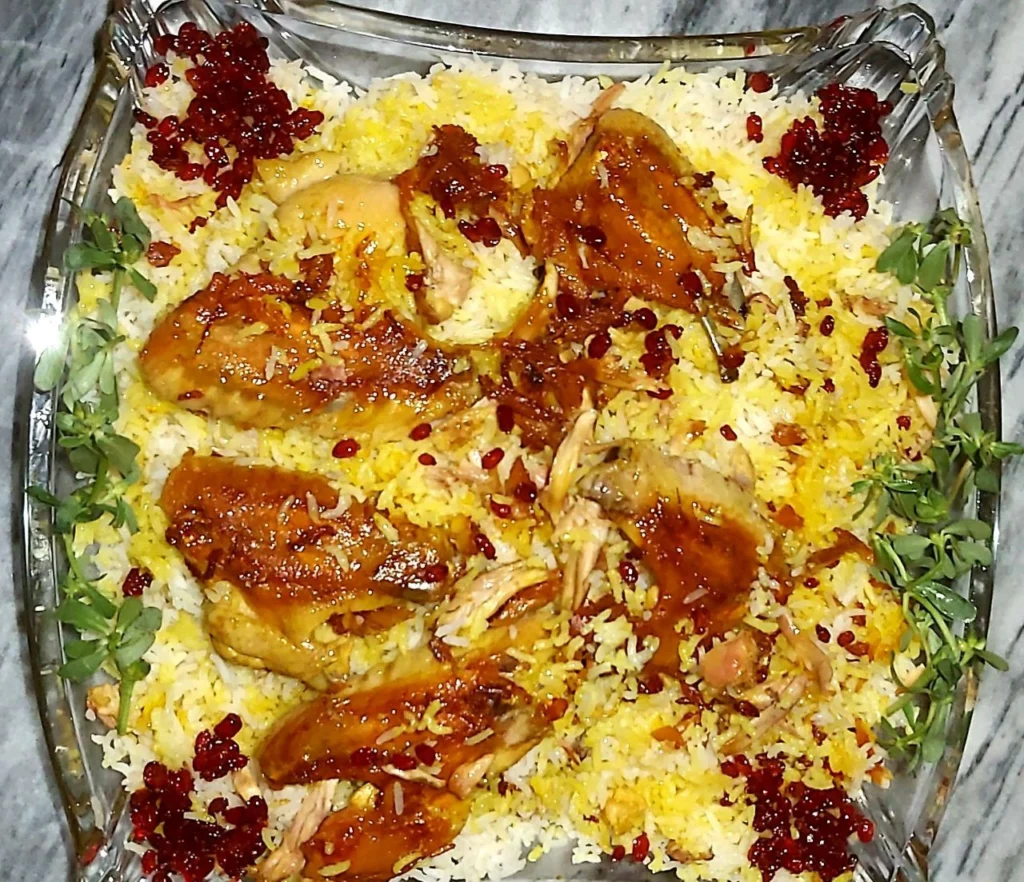Zereshk Polo ba Morgh – A Classic Persian Dish of Barberry Rice and Saffron Chicken

Among the crown jewels of Persian cuisine, Zereshk Polo ba Morgh, or barberry rice with saffron chicken, stands tall as one of the most iconic and beloved dishes served in Iranian households. It’s a feast for both the eyes and the taste buds — a harmonious blend of flavors, colors, and textures that captures the essence of Iranian culinary tradition.
In this article, we’ll explore what makes this dish so special, the key ingredients, how to prepare it perfectly, and why it remains a staple at Persian celebrations and dinner tables alike.
What Is Zereshk Polo ba Morgh?
Zereshk Polo ba Morgh translates to “barberry rice with chicken.” It is a beautifully composed dish made from fluffy Persian-style rice infused with saffron, topped with tart barberries (zereshk), and served with tender chicken simmered in a lightly spiced tomato and onion sauce.
It’s a dish that balances sweet and sour notes, offers rich golden color thanks to saffron, and includes the subtle crunch and tanginess of sautéed barberries. It is not only delicious, but also visually impressive, making it a popular choice for guests, weddings, and holiday dinners like Nowruz (Persian New Year) and Shab-e Yalda (Winter Solstice celebration).
Ingredients That Make This Dish Shine
Each ingredient in Zereshk Polo plays a specific role in creating the final flavor profile:
1. Rice (Polo)
High-quality long-grain basmati rice is preferred for its ability to become fluffy and separate when cooked. In Persian cooking, rice is often parboiled and then steamed — a method that gives the rice a light texture and creates a crispy golden crust on the bottom called tahdig.
2. Zereshk (Barberries)
These small, ruby-red berries are tart and slightly bitter, providing a pop of color and brightness to the dish. They are typically sautéed with a bit of butter or oil and sometimes sugar to mellow their sourness.
3. Saffron
The world’s most precious spice, saffron gives both aroma and a golden hue to the rice. It is dissolved in hot water to extract maximum color and fragrance.
4. Chicken (Morgh)
Chicken pieces, usually thighs or drumsticks, are seasoned and seared, then cooked in a sauce made from onions, turmeric, and tomato paste. The result is deeply flavorful and tender meat with a slight tang from the sauce.
5. Optional Garnishes
Slivered almonds or pistachios, orange peel, or caramelized onions can be used to elevate the presentation and taste.

Step-by-Step Preparation
Here’s a basic outline of how to prepare Zereshk Polo ba Morgh at home:
Step 1: Parboil the Rice
Rinse the rice several times to remove excess starch, soak it in salted water for 30–60 minutes, then bring to a boil and cook until the grains are slightly soft but still have a bite. Drain and set aside.
Step 2: Cook the Chicken
Sauté chopped onions in oil until golden, add turmeric, then add the chicken pieces and brown on all sides. Stir in tomato paste, salt, pepper, and optionally a bit of lemon juice. Add water, cover, and simmer until the chicken is fully cooked and tender.
Step 3: Prepare the Zereshk
Lightly sauté the barberries in butter with a pinch of sugar, being careful not to burn them as they are delicate and can turn bitter quickly.
Step 4: Steam the Rice
In a nonstick or heavy-bottomed pot, add a bit of oil and layer the rice carefully, optionally adding a thin layer of yogurt and saffron rice at the bottom for tahdig. Cover with a towel-lined lid and steam for about 45 minutes until fully cooked.
Step 5: Assemble and Serve
Fluff the rice and gently mix in saffron rice and barberries. Plate the rice in a dome or mold shape, top with additional barberries and nuts, and serve with the chicken on the side or around the rice.
Tips for Success
Use real saffron, not substitutes like turmeric, for authentic color and aroma. A tiny pinch goes a long way.
To prevent barberries from burning, keep the heat low and stir constantly.
For extra flavor, cook the chicken a day in advance — the flavors deepen overnight.
Serve with plain yogurt, pickled vegetables (torshi), or a side salad for balance.
Cultural Significance
Zereshk Polo ba Morgh is more than just a meal — it’s a symbol of hospitality and celebration. It’s the dish many Iranians remember from their childhood, family gatherings, and holidays. Its presence on the table communicates effort, care, and the desire to please guests — a core value in Persian hospitality.
In modern Iranian cuisine, this dish is often served at weddings, funerals, and formal events, as well as for Friday family dinners. Its beauty and balance make it a universal favorite, even among those new to Persian food.
Final Thoughts
Whether you’re diving into Persian cooking for the first time or looking to elevate your hosting menu, Zereshk Polo ba Morgh is a must-try dish. It captures the heart of Iran’s rich culinary heritage with its vibrant colors, sophisticated flavors, and elegant presentation. Serve it once, and you’ll find it returning to your dinner table time and again.
So go ahead — soak your rice, grind your saffron, and let your kitchen fill with the irresistible aroma of one of Iran’s most treasured dishes.
I’m glad you were with us. If you have any comments or experiences related to this subject, please share them below this post. Thank you.



